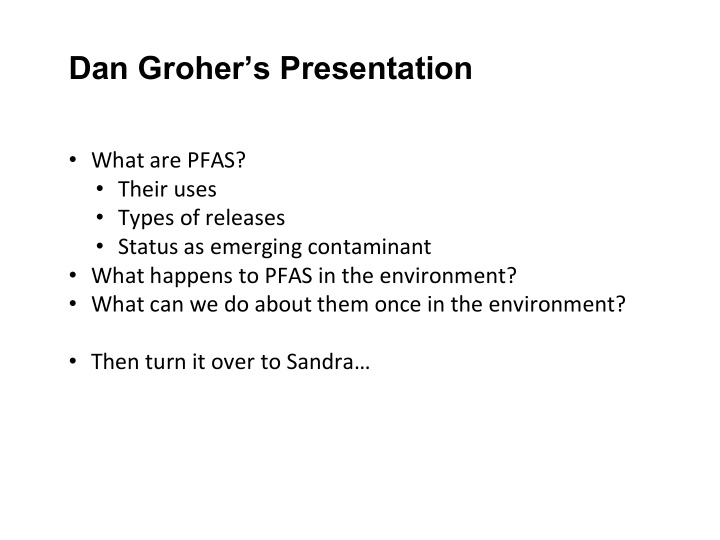



Dan Groher’s Presentation • What are PFAS? • Their uses • Types of releases • Status as emerging contaminant • What happens to PFAS in the environment? • What can we do about them once in the environment? • Then turn it over to Sandra…
What are PFAS? C ARBON ATOMS • Perfluoroalkyl and Polyfluoroalkyl Substances (PFAS) • Thousands of different (but very similar) chemicals • Includes Perfluorooctanoic acid (PFOA) and perfluorooctanesulfonic acid ( PFOS ) – most commonly discussed and regulated F LUORINE ATOMS “Carbon-Fluorine • In recent years, experts have become bond, one of the concerned by potential PFAS health effects strongest bonds in • We have learned a lot about PFAS in the last nature” 5+ years. But so much more to learn … à Consequently, US EPA and many States have varying health standards
Some of the Many Uses of PFAS Aerospace Apparel Building and Chemicals and Electronics Construction Pharmaceuticals Oil & Gas Energy Healthcare and Aqueous Film Semiconductors Hospitals Forming Foam 2
PFAS Development…. 1930’s 19 ’s 1940’s 19 ’s 1950’s 19 ’s 1960’s 19 ’s Aqueous Film Forming Teflon accidentally DOD Research Consumer Foam (AFFF) is developed discovered in 1938 (Uranium Enrichment) products … and Evolution Page2 19 1970’s ’s 2000 2000’s ’s Cu Current Product expansion & PFAS is found Changing regulatory climate enhancements worldwide in biota à Lawsuit settlements Emerging Contaminant Development of new PFAS
What is an Emerging Contaminant? Chemicals that can enter the environment C ARBON ATOMS and present real or potential human health or environmental concern… and either Do not have peer-reviewed human health standards; F LUORINE ATOMS or Standards/regulations are evolving due to new science, detection capabilities or pathways.
Large Scale Potential PFAS Sources Refineries Pump & Paper Wastewater Military Sites Treatment Plants Metal Plating Various Landfills & Waste Airports Manufacturing Disposal Areas
Conceptual Site Model – AFFF Site ITRC, 2017
How Can We Protect Drinking Water from PFAS? 1. Locate the source and intercept the dissolved PFAS a) Install an interceptor well b) Install a “barrier” to prevent dissolved PFAS from reaching water well(s) c) Requires remedial investigation to find source and/or plume 2. Destroy the PFAS in-situ (in the ground) – we do NOT really know how to do this yet because PFAS are SO stable 3. Treat the drinking water pumped from wells
Typical Options for Treating Drinking Water Containing PFAS Sorption Media Granular Activated Carbon ü Very commonly (GAC) – most familiar applied – towns are familiar ü Depends on water Anion Exchange Resin (AIX) quality (e.g., low – likely most cost effective organic or metals) ü No liquid waste stream of concern Membrane Filter – not common ü Comparatively lower cost (vs. membrane) ü BUT, high media replacement costs 19
New PFAS Treatment Facilities – Ayer Example § AIX for PFAS Removal Ve Vessel Hei Height:16’ 16’-10” 10” Vessel Di Ve Diameter:12’ 12’ § Media selected by lab studies § ~ $3 Million and 1 year to build § Treat up to 2 million gals/day 41’ 41’-8” 8” 43’-4” 43’ 4” Ex Existing g WTP WT Ne New PFAS Treatment Approximately 1, Ap 1,800 800 ft ft 2 Bu Building
More recommend